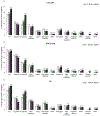Trends and Patterns of Tobacco and Nicotine Product Use Among Youth in Canada, England, and the United States From 2017 to 2019
- PMID: 33839006
- PMCID: PMC8403620
- DOI: 10.1016/j.jadohealth.2021.02.011
Trends and Patterns of Tobacco and Nicotine Product Use Among Youth in Canada, England, and the United States From 2017 to 2019
Abstract
Purpose: The tobacco and nicotine market is diversifying. Implications for public health will depend on trends in use, including overall use, and who is using these products. This study examined differences over time (2017-2019), across countries (Canada, England, the United States (US)), and by smoking and vaping, in use of other tobacco/nicotine products and overall use.
Methods: The study includes online repeat cross-sectional surveys of youth aged 16-19 years in Canada (N = 11,714), England (N = 11,170), US (N = 11,838) in 2017, 2018, and 2019. Past 30-day use of tobacco/nicotine products (any, cigarette, e-cigarette, other combusted [cigars/cigarillos/waterpipe], other non-combusted [smokeless tobacco/nicotine replacement therapies) were examined by country, year, and, for other combusted and non-combusted products, past 30-day cigarette smoking and vaping. Use of emerging products (IQOS, nicotine pouches) was explored in 2018-2019.
Results: From 2017 to 2019, use of any product increased in Canada (17.1%-23.2%, AOR = 1.07 [95% CI = 1.04-1.09]) and the US (18.0%-24.0%, AOR = 1.06 [1.04-1.09]) but not England (20.8%-21.7%, AOR = 1.01 [.99-1.03]). Use of other combusted products (cigars/cigarillos/waterpipe) showed little change (Canada: 8.1%-7.8%; England: 6.3%-7.3%; US: 8.6%-8.5%; p ≥ .151). Use of other non-combusted products (smokeless/nicotine replacement therapies) increased in all countries (Canada: 1.5%-3.2%, AOR = 1.02 [1.01-1.02]; England: 1.4%-2.6%, AOR = 1.02 [1.01-1.03]; US: 3.3%-4.9%, AOR = 1.02 [1.01-1.02]). Vaping increased in all countries (Canada: 8.4%-17.8%; England: 8.7%-12.6%; United States: 11.1%-18.5%; all p < .001). Smokers and vapers reported greater use of other combusted and non-combusted products than those who neither smoked/vaped (p < .001). Emerging product use was rare (≤1.5%).
Conclusions: Youth past 30-day tobacco and nicotine product use increased from 2017 to 2019 in Canada and the United States, largely due to increases in vaping and other non-combusted products. "Other" tobacco/nicotine products were used predominantly by youth who smoked cigarettes and/or vaped.
Keywords: Adolescent; Electronic nicotine delivery systems; Nicotine; Prevalence; Smoking; Surveys and questionnaires; Tobacco products.
Copyright © 2021 Society for Adolescent Health and Medicine. Published by Elsevier Inc. All rights reserved.
Conflict of interest statement
Figures


Similar articles
-
Patterns of Non-Cigarette Tobacco and Nicotine Use Among Current Cigarette Smokers and Recent Quitters: Findings From the 2020 ITC Four Country Smoking and Vaping Survey.Nicotine Tob Res. 2021 Aug 18;23(9):1611-1616. doi: 10.1093/ntr/ntab040. Nicotine Tob Res. 2021. PMID: 33693833 Free PMC article.
-
Characterizing Heated Tobacco Product Use Among Adult Cigarette Smokers and Nicotine Vaping Product Users in the 2018 ITC Four Country Smoking & Vaping Survey.Nicotine Tob Res. 2022 Mar 1;24(4):493-502. doi: 10.1093/ntr/ntab217. Nicotine Tob Res. 2022. PMID: 34669964 Free PMC article.
-
Use of disposable e-cigarettes among youth who vape in Canada, England and the United States: Repeat cross-sectional surveys, 2017-2023.Addiction. 2025 Mar;120(3):405-413. doi: 10.1111/add.16596. Epub 2024 Jul 1. Addiction. 2025. PMID: 38946542 Free PMC article.
-
Regulatory Approaches and Implementation of Minimally Addictive Combusted Products.Nicotine Tob Res. 2022 Mar 1;24(4):453-462. doi: 10.1093/ntr/ntab138. Nicotine Tob Res. 2022. PMID: 34192324 Free PMC article.
-
Cardiopulmonary Impact of Electronic Cigarettes and Vaping Products: A Scientific Statement From the American Heart Association.Circulation. 2023 Aug 22;148(8):703-728. doi: 10.1161/CIR.0000000000001160. Epub 2023 Jul 17. Circulation. 2023. PMID: 37458106 Review.
Cited by
-
Supporting Youth Vaping Cessation With the Crush the Crave Smartphone App: Protocol for a Randomized Controlled Trial.JMIR Res Protoc. 2023 Jan 27;12:e42956. doi: 10.2196/42956. JMIR Res Protoc. 2023. PMID: 36705967 Free PMC article.
-
Using Marketing Frameworks to Predict the Effects of E-Cigarette Commercials on Youth.Young Consum. 2023 Feb 28;24(2):149-164. doi: 10.1108/yc-07-2022-1555. Epub 2022 Dec 5. Young Consum. 2023. PMID: 37377451 Free PMC article.
-
Self-assembled core-shell nanoparticles with embedded internal standards for SERS quantitative detection and identification of nicotine released from snus products.Front Chem. 2024 Mar 27;12:1348423. doi: 10.3389/fchem.2024.1348423. eCollection 2024. Front Chem. 2024. PMID: 38601887 Free PMC article.
-
Trends in E-Cigarette and Tobacco Cigarette Purchasing Behaviors by Youth in the United States, Canada, and England, 2017-2022.Int J Public Health. 2023 Nov 14;68:1606234. doi: 10.3389/ijph.2023.1606234. eCollection 2023. Int J Public Health. 2023. PMID: 38033762 Free PMC article.
-
Trends in exposure to and perceptions of e-cigarette marketing among youth in England, Canada and the United States between 2017 and 2019.Health Educ Res. 2022 Jan 29;36(6):657-668. doi: 10.1093/her/cyab039. Health Educ Res. 2022. PMID: 34849859 Free PMC article.
References
-
- Levy DT, Mumford EA, Cummings KM, Gilpin EA, Giovino G, Hyland A, Sweanor D, Warner KE. The Relative Risks of a Low-Nitrosamine Smokeless Tobacco Product Compared with Smoking Cigarettes: Estimates of a Panel of Experts. Cancer Epidemiol Biomarkers Prev. 2004. doi. - PubMed
-
- McNeill A, Brose LS, Calder R, Bauld L, Robson D. Vaping in England: an evidence update including mental health and pregnancy, March 2020: A report commissioned by Public Health England. 2020. https://www.gov.uk/government/publications/vaping-in-england-evidence-up....
Publication types
MeSH terms
Substances
Grants and funding
LinkOut - more resources
Full Text Sources
Other Literature Sources
Medical
Miscellaneous

